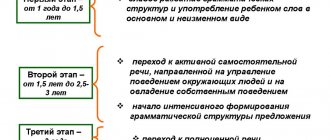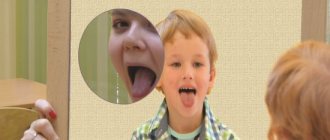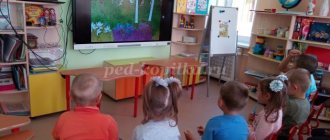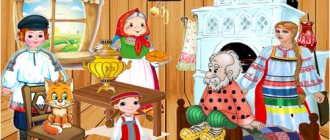Younger preschoolers have unique characteristics in the development of speech: their psyche is especially sensitive to language, to its semantic and sound aspects. Language enrichment occurs as a result of performing new tasks that arise during communication and during one’s own activities. All this creates the prerequisites for the further formation of speech.
Speech, as a rule, includes many short sentences: the words in it are selected based on specific subject situations, which is manifested in a variety of nouns, verbs and pronouns. However, at this age you can also find words that denote intellectual and volitional actions, as well as words that denote modality.
Speech is of great importance for the comprehensive development of younger preschoolers. After all, this is the main means of communication between children. Children do not understand all grammatical structures of words, but speech allows them to draw attention to actions and objects. The actions of adults play an important role in this case, because children try to imitate them. It is imitation of adults that becomes one of the main mechanisms for the development of communication at this age.
Formation of speech of preschool children at the present stage
Formation of speech in preschool children today is one of the most important tasks facing preschool educational institutions. Speech, being a means of communication, is woven into all types of children’s activities: in their games, in entertainment, in productive activities, in walks, etc.
According to the Federal State Educational Standard, which applies to the structure of the educational program in preschool institutions, the formation of the speech of preschoolers becomes one of the tasks of the field of education “Communication”. The content of this task is related to achieving the goal of mastering constructive means and ways of interacting with other people.
Structure of work on speech formation in children
In the structure of work on the formation of speech of young preschoolers, these forms of work can be used in combination, as this makes it possible to solve problems more efficiently. At the same time, situations of an educational nature are considered quite effective, as well as communication situations, which are also used in practice for the development of children’s speech in the process of joint activities and in routine moments. This form of interaction makes it possible to apply a differentiated approach to preschoolers and largely individualize the educational process, making it personality-oriented.
The main speech function at this stage is communicating information, establishing and maintaining social connections, and influencing other people.
Lesson notes on speech development in the junior group of kindergarten
Speech development classes are an opportunity for teachers and parents to complement thematic classes and activities throughout the year.
Articulation gymnastics for the sound L
"Dishes"
When practicing the grammatical features of speech, attention should be paid to prepositions.
The teacher may offer to cook lunch for the doll. To do this, you need to get the necessary dishes from the cabinet.
— What dishes are in the closet? Which one do we need? Place the pan on the stove. Let's pour water into it. Using a knife, cut the vegetables on a cutting board. Stir with a ladle.
The suffix helps change the dimensions of the described object.
— We will eat the soup in tablespoons, and the berries from the compote in teaspoons.
In this way, children learn word formation.
— Bread should be put in the bread bin, sugar in the sugar bowl, salt in the salt shaker.
"Professions"
The guys can be sent on an imaginary journey through the country of “Professions”. Due to this, words denoting actions (verbs) are practiced. The teacher can list the actions performed by the toys and ask the children to guess their profession. For example: “The gnome Petya works in the garden, plants flowers, waters, removes dry grass, loosens the ground. Petya - (gardener)."
You can do the opposite. Introduce a toy character and name his profession, and then list as many actions as possible.
- This is Doctor Aibolit. Let's remember what he does (he treats the throat, takes the temperature, gives injections, gives pills, bandages, applies ointments).
"Defender of the Fatherland Day"
In the second half of February, events dedicated to February 23 are held in the garden. While developing their vocabulary, children describe objects they know and learn new words and concepts related to this topic.
For example, there may be several toys on the teacher’s desk at once. Children should be asked to name them in turn: dump truck, bus, military truck with soldiers, racing car.
— What can you call these toys? (transport).
Note! You can describe a racing car and a soldier's truck (the truck is large, but the kart is small; there are many soldiers in the back, and there is one racer in the kart; the military vehicle is green, and the sports vehicle is red, etc.).
Children can also finish sentences they have started:
- the tanker serves... (in the tank);
- The border guard guards... (the border);
- the pilot is flying in... (an airplane).
Role-playing game
"Folk toy"
The purpose of such a lesson is to become familiar with the grammatical features of speech. The teacher can introduce the children to a new toy, show how it opens and what is inside.
— Matryoshka is a folk toy. It was made by a master. He made it out of wood, and then painted the face and clothes with paints.
Note! The children should look at the wooden toy and the plastic doll sitting next to it, and the teacher should ask what the Matryoshka does not have (moving arms and legs, neck, textile dress, hairstyle, etc.). Answers must be in the genitive case.
Speech development program for preschoolers according to O. S. Ushakova.
"Maslenitsa"
At the beginning of spring, you can organize a discussion of Maslenitsa with the guys. The teacher should talk about traditional winter fun, treats and games, and teach children nicknames.
“Burn, burn brighter - the summer will be hotter,
And winter is warmer, and spring is nicer.
Burn, burn clearly so that it doesn’t go out!
Where the snowdrifts lie, there will be more berries.
Let the bees bring more honey to the deck.
Let the wheat spike thickly in the fields.”
Development of speech at an early age
Let's discuss the dynamics of studying different speech aspects.
Sound pronunciation. Children's hearing becomes quite developed already in the early stages of development. At one and a half years old, children correctly reproduce syllables in words consisting of two syllables. And at two years old, in 75 percent of cases they can correctly name all three syllables in three-syllable words.
Preschoolers perceive the rhythm in a word, its intonation coloring, and stress quite easily. At the end of the second year of schooling, children have mastered entire groups of spoken sounds.
At two years old, when a child hears a sample, he tries to correct his own pronunciation. At this time, not having the ability to correctly pronounce any sounds, children pick up their erroneous pronunciation from others.
The specificity of pronunciation in children at three and four years old is approximately the same. According to A.N. Gvozdev, at this time the child learns sounds, and they can both pronounce them correctly and make omissions, replace and liken sounds, and soften them.
At home in the bathroom
While bathing, check the names of the child's body parts. Consider the items in the bathroom. Name them, show the parts. Explain the purpose of these items.
Development of the muscles of the lips, cheeks and tongue
"My mood". Invite your child to show different moods (happy, sad) in front of the mirror.
“Brushing our teeth.” We clean the lower and upper teeth with a tongue. We run our tongue over the teeth from left to right and from top to bottom.
Breathing development
"White Boats" Blow on foam, helium (glycerin) stains, boats (floating objects) in the basin.
Development of auditory attention
Listen and determine the difference between the noise of the water from the tap and the shower.
Formation of vocabulary and grammar
Children's vocabulary is enriched, and the forms of its use are improved. If, while observing pictures, children’s attention is drawn to the beauty of nature, then at the age of 4-6 children begin to learn the appropriate terms and methods of characterizing nature. Although at this age they still only talk about the size and color of objects, approximately 30 percent of their definitions are detailed, containing enumerations, characteristics and elements of comparison.
Children also begin to differentially use grammatical speech structure. The most favorable situation that would encourage children to include complex sentences in their statements is one in which something needs to be explained and convinced of something.
Before the age of 4, preschoolers encounter situations of inductive relationships between play actions and speech. Children comment on what they see, talk about what they plan to do or have already done, but they are silent when they perform direct actions.
At three and a half years old, children gradually begin to form a speech basis for the development of friendly relationships and for mastering behavioral rules. But to do this, you need to master the specifics of communication and understand ways to improve it.
At the same time, the Federal State Educational Standard pays attention to games as an effective form of organizing children’s activities. Play is the main activity of preschoolers. In games they develop, learn about the world around them in a form accessible to them. At the same time, games can be used to solve pedagogical problems.
Article:
Younger preschoolers have unique characteristics in the development of speech: their psyche is especially sensitive to language, to its semantic and sound aspects.
Language enrichment occurs as a result of performing new tasks that arise during communication and during one’s own activities. All this creates the prerequisites for the further formation of speech. Speech development in younger preschoolers
The purposeful development of speech in younger preschoolers is one of the leading areas of pedagogical activity, ensuring the timely mental development of children. Speech is the basis of the human mind, the crown of nature’s creation; from early childhood, human life is connected with language.
In the development of a child’s speech, the leading role is played by adults: the family (parents) and the kindergarten teacher. The child’s success in mastering the language depends on the culture of speech of adults and how they talk to the child, how much time they devote to verbal communication.
Thus, an adult’s speech must comply with the norms of literary language and literary colloquial speech both in terms of the sound aspect (diction, tempo, pronunciation of sounds and words) and in terms of the richness of the vocabulary, accuracy of word use, grammatical correctness and coherence.
The main goal of speech development of young children:
- formation of oral speech and verbal communication skills
- Main tasks of speech development:
- formation of a dictionary
- development of sound culture of speech
- development of grammatical structure of speech
- development of coherent speech
- introducing children to fiction.
When developing speech, you need to take care not only that the child pronounces as many words as possible, but also that the heard and spoken words are supported by living images and specific content. And to do this, you need to not only talk with the child about this or that, but also introduce him to the real world of things, phenomena, events. It is necessary that he sees what they are talking about with his own eyes, hears with his own ears and, if possible, acts with his own hands. During this period, the baby is especially interested in the names of objects and phenomena, and every now and then he asks adults the question: “What is this”? Take advantage of this favorable moment, communicate more with your child, thus accumulating his passive vocabulary.
You can and should talk to a 2-3 year old child about things that are not currently in his field of vision, for example, what he saw this morning on a walk or even some time ago. This develops his speech, trains his memory, teaches him to listen to other people’s speech and understand it.
More often, look at various pictures with a plot that he understands with your child, discuss them, and come up with short stories. In this case, the adult must give the child a sample of correct speech.
If a child pronounces any sounds or words incorrectly, you should not laugh or imitate him. You cannot scold your child for poor speech and demand that he immediately and correctly repeat a word that is difficult for him. This will lead to the child trying not to use some words at all or replacing them with others. Do not imitate your child by repeating words he pronounces incorrectly. And there is no need to try to point out to the child that this is wrong. It is better to repeat the word after the baby, but pronounce it clearly so that all sounds can be heard.
Speech development in children 3-4 years old occurs especially quickly. As a rule, by the age of 3, a child almost masters his native language. The active vocabulary of children from 3 to 4 years old grows literally by leaps and bounds, up to about 100 new words per month. If at three years old a child needs a few hundred words to communicate, at four years old this figure reaches 1.5-2 thousand words. At the same time, we must remember that in a family, adults use an average of 3 to 5 thousand words for everyday communication.
The sound design of words also improves quickly, and phrases become more developed. However, not all children have the same level of speech development: some pronounce words clearly and correctly by the age of three; others do not speak clearly enough, pronounce words incorrectly; Still others speak insufficiently clearly and pronounce certain sounds incorrectly. The most typical mistakes are omission and replacement of sounds, rearrangement of sounds and syllables, violation of the syllabic structure (abbreviation of words - “tamva”, instead of tram, incorrect stress).
The speech of three-year-olds is the same. They pronounce all verbs in the present tense. The baby's understanding of the past or future is still limited. The sentences are similar to each other: the subject comes first, then the predicate, then the object. Kids easily perceive simple nominal sentences. At this age, children develop a special interest in words. Kids try to establish the meaning of words, their origin, create their own words (a mug instead of a spring). The baby is attracted by the sound design of words, and he even tries to correct poorly speaking peers, although he still cannot determine which sound or often the word is pronounced incorrectly.
The child cannot yet independently determine what sounds a word consists of, establish their sequence, or decompose the word into parts (syllable sounds).
The main directions of work on speech development in the second junior group are as follows:
Expanding children's vocabulary
Development of sound culture of speech
Development of grammatical structure of speech
Development of coherent speech (monologue and dialogic)
Development of figurative speech
The main forms are the organization of educational situations and communication situations. Teachers organize educational situations - looking at pictures, toys, reading fairy tales and short stories, learning poems. Their goal is to teach children the ability to compose stories, tell fairy tales and act out them, the ability to ask questions and retell heard content, and compose their own story based on the listened content. We organize this educational situation at any time of the day - in the morning, in the evening, during a walk with one or more children. We repeat one situation several times with different children. Communication situations most often arise spontaneously, and teachers see and support such situations. They try to grasp the meaning of the child’s statement, which often consists of one or two short phrases, and with their questions encourage the child to engage in dialogue or a more complete statement.
An important role in the development of a child’s speech belongs to the artistic word. Kids love poetry very much. They are pleased with the rhythm of the verse, they enrich children's experiences, develop thinking, and awaken a love for the literary word and their native language.
Poems, nursery rhymes, jokes, accompanied by playful activities, delight children.
Kids need to read short poems, simple ones, with images that are understandable to the child (poems by A. Barto from the “Toys” series). They have access to the simplest fairy tales - “Ryaba the Hen”, “Turnip”, “Teremok”, “Kolobok”. Children of this age perceive vividly, quickly remember and begin to repeat what they like.
More opportunities for speech development open up while walking with your child. Bright summer sun or fluffy snowflakes - all this attracts a child and can serve as a topic for conversation with him.
When looking at pictures in books and magazines, name and explain to your child everything that he sees in front of him. Repeat the desired word several times, ask to see the object you named, and then ask him to name the word himself. Be sure to praise your baby and celebrate his successes.
Draw your child’s attention more often in everyday life to the colors of objects, ask leading questions: “What color is your blouse? What about the boots? When your child draws, be sure to highlight with a pencil what color he is drawing.
There is a close connection between speech development and the development of gross and fine motor skills. Therefore, we recommend that you constantly use fine motor skills games when communicating with your child - stringing beads and buttons on wire, using finger games, finger painting, sculpting from plasticine, salt dough, clay. Games with cereals, with shells of seeds, nuts, large fruit seeds. Try putting together large puzzles and describing the picture that will come out.
Didactic games in speech development
To increase the efficiency of using the game, it is necessary to use didactic games, systematize them and arrange them in the form of a card index.
The peculiarity of didactic games is that their educational content includes rules and actions, which helps children learn the content. After all, the motive for completing tasks arises precisely in the process of gaming activity. Children play, but at the same time they acquire the necessary information and use previously acquired knowledge.
This allows us to make didactic games an important type of organization of teaching preschoolers their native language.
The method of forming the speech of younger preschoolers for the optimal solution of problems of a speech nature, to maintain interest and to create an atmosphere of spontaneity, as well as for emotionality, involves the use of the following methods and techniques:
- active use of communicative as well as gaming motivation;
- creating problem situations, alternating direct teaching methods with game ones, as well as introducing indirect influence methods - game rules, didactic materials, dramatization techniques;
- the use of children's personal and choral responses, as well as motor and verbal ones;
- the use of a variety of demonstration materials;
- the use of tasks in which preschoolers change their posture and move (the game specificity of these tasks forces children to accept imaginary situations and teaches them play actions).
Small means of folklore in speech development
To develop sound speech culture, games are used, as well as special exercises, various speech materials: onomatopoeia, sayings, nursery rhymes, rhymes, tongue twisters, stories, dramatizations, fairy tales and visual materials.
Nursery rhymes are a small-form folklore genre.
Nursery rhymes are of great importance for the formation of younger preschoolers. The nursery rhymes are unique, which is valuable for children. They activate the impact of speech flow on children. Children begin to distinguish speech from other sound signals and focus their attention on it.






